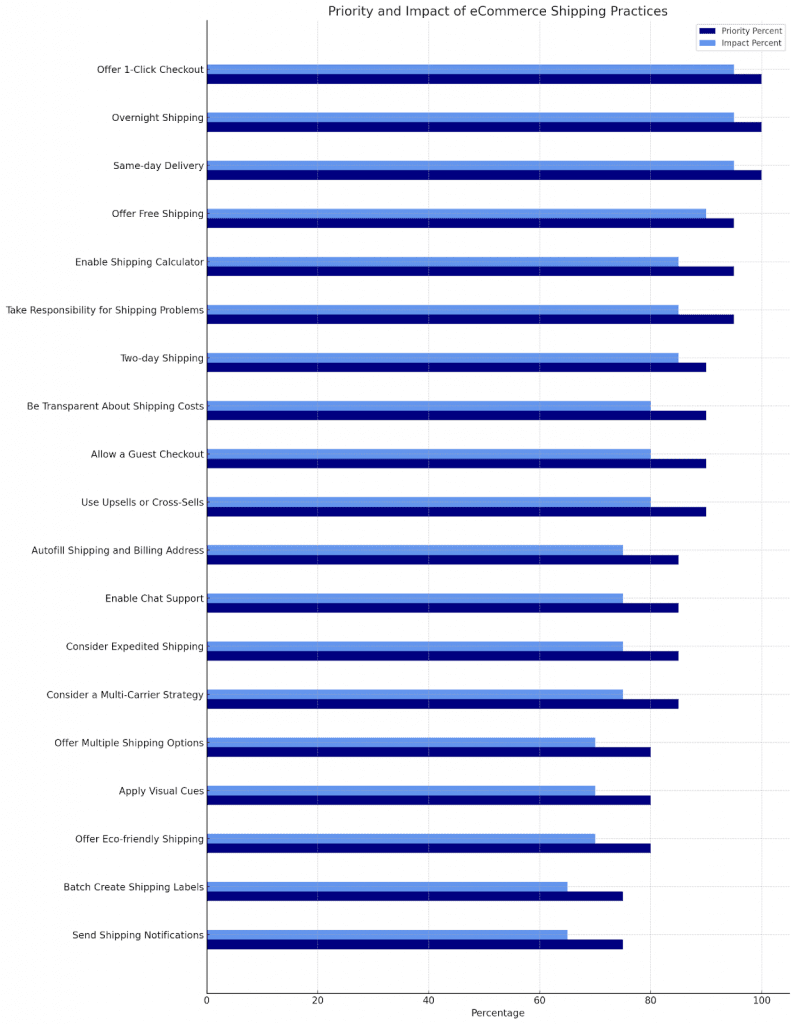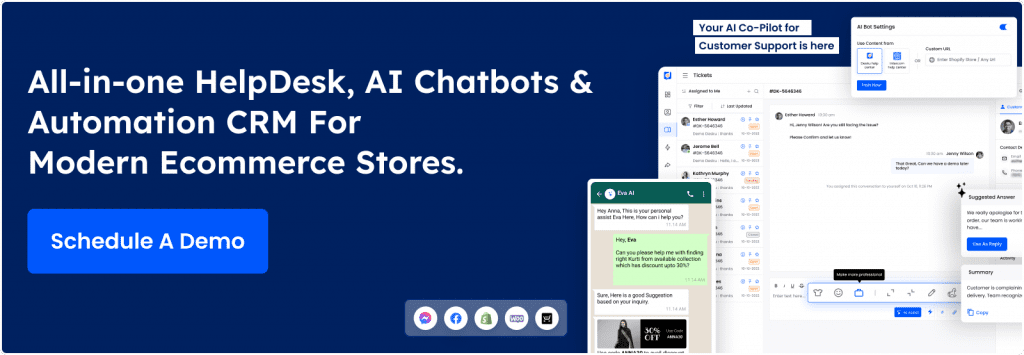In this competitive eCommerce market, shipping isn’t just a logistical necessity—it’s a strategic tool that can significantly impact your revenue and customer satisfaction. With the digital marketplace becoming more crowded, businesses are constantly seeking innovative ways to stand out and retain customers.
Enter the best-kept secrets : 17 transformative eCommerce shipping best practices that could be your golden ticket to not only enhancing operational efficiency but also substantially boosting your revenue.
This guide unveils these hidden gems, from optimizing your shipping strategies to leveraging technology and beyond, designed to improve your eCommerce business to new heights. Whether you’re a small startup or an established player, these insider tips will redefine how you think about shipping and its potential to drive growth and customer loyalty.


Why Does Checkout Abandonment Occur?
Checkout abandonment occurs for a variety of reasons, reflecting the challenges and hesitations that shoppers face during the final stages of their online purchasing journey. Key factors contributing to checkout abandonment include:
- Unexpected Costs: Additional fees, such as shipping, taxes, and handling charges, added at checkout can deter customers.
- Complicated Checkout Process: A checkout that involves too many steps or requires excessive information can overwhelm and frustrate shoppers.
- Mandatory Account Creation: Forcing customers to create an account before completing a purchase can be a significant barrier.
- Security Concerns: Shoppers are cautious about online security. Any doubt regarding the safety of their personal and payment information can lead to abandonment.
- Limited Payment Options: Lack of preferred payment methods can prevent a customer from completing their purchase.
- Poor Mobile Experience: A checkout that isn’t optimized for mobile devices can turn away the increasing number of users shopping on smartphones and tablets.
- High Shipping Costs: Expensive shipping options or the lack of free shipping can be a deal-breaker for many customers.
- Long Delivery Times: Extended delivery timelines can discourage purchases, especially if customers need items by a specific date.
- Lack of Transparency: Hidden costs or details that only emerge at checkout can lead to a loss of trust and abandonment.
- Website Performance Issues: Slow loading times or glitches during the checkout process can cause frustration and lead to abandonment.
Why is Checkout Page Optimization Important?
- Checkout Optimization is Key: Vital for maximizing conversions and enhancing customer experience in eCommerce.
- Final Step in Customer Journey: Converts potential buyers into paying customers; a pivotal sale moment.
- Impact of Cumbersome Checkouts: Complex, confusing, or lengthy processes lead to cart abandonment and lost revenue.
- Streamlining Reduces Friction: Essential for minimizing purchase barriers; aims for an intuitive and user-friendly checkout.
- Features for Improved Experience: Guest checkout, pre-filled forms, and diverse payment options enhance efficiency.
- Direct Influence on Bottom Line: Lowering cart abandonment boosts conversion rates and revenue.
- Benefits Beyond Sales: Smooth checkouts enhance customer satisfaction, brand loyalty, and encourage repeat business.
- Research Backs Optimization Benefits: Studies show checkout process simplification directly elevates conversion rates.
- Statistical Insight: 53% of shoppers halt their purchase due to the prolonged duration of shipping times.
- Industry-Wide Issue: On average, 70% of checkouts across all industries face abandonment.
- Top Abandonment Reasons: Lack of free shipping and slow shipping speeds are primary deterrents.
- Overall Business Impact: Clear optimization of checkout processes significantly affects conversion rates and business performance.
Smart eCommerce Shipping Best Practices
Step into the smart shipping era, where precision and customer delight converge. These practices are your first steps towards transforming shipping from a mere necessity into a strategic asset.
1). Be Transparent About Shipping Costs
Transparency in shipping costs is not just a courtesy; it’s a strategic move that builds trust with your customers. When businesses are upfront about shipping fees, customers are less likely to abandon their carts due to unexpected charges.
Clear communication regarding shipping costs from the outset can significantly enhance the customer experience, leading to higher satisfaction and increased likelihood of repeat purchases. This practice demystifies costs for buyers, ensuring they feel informed and valued throughout their shopping journey.
2). Consider a Multi-Carrier Strategy
Employing a multi-carrier strategy diversifies your shipping options, providing flexibility and resilience against unexpected delays or issues with a single carrier. This approach allows businesses to compare rates, delivery times, and service quality across different carriers, optimizing for cost-efficiency and reliability. Moreover, it enables companies to offer a broader range of shipping options to customers, catering to various preferences and needs, ultimately enhancing customer satisfaction and loyalty.
3). Consider Offering Free Shipping
- Powerful Purchase Incentive: Free shipping significantly impacts an online shopper’s decision-making process, serving as a strong motivator to complete a purchase.
- Encourages Larger Orders: By setting minimum purchase thresholds for free shipping, businesses can subtly encourage customers to add more items to their cart, effectively increasing the average order value.
- Promotions and Marketing Strategy: Utilizing free shipping as a promotional tool or during specific marketing campaigns can attract more visitors and convert them into paying customers.
- Balancing Costs and Benefits: Although offering free shipping might introduce an initial cost to the company, the long-term advantages such as higher sales volumes and enhanced customer loyalty often compensate for these expenses.
- Competitive Edge: In a market where consumers are bombarded with choices, the option of free shipping can make your business stand out as a preferred option, drawing in a larger customer base.
- Customer Retention: The convenience and savings from free shipping are key factors in building a loyal customer base, as satisfied customers are more likely to return for future purchases.
- Strategic Implementation: Careful planning and strategic implementation of free shipping policies can optimize its benefits, making it a sustainable practice that supports business growth and customer satisfaction.
4). Offer multiple shipping options with accurate costs
Providing customers with multiple shipping options along with precise cost estimates empowers them to make choices that best suit their needs and budget. This flexibility can significantly improve the shopping experience, leading to increased customer satisfaction and reduced cart abandonment rates. Accurate cost information also helps in setting realistic expectations, ensuring customers are fully informed about their delivery choices, fostering trust and transparency between the customer and the business.

5). Send Shipping Notifications
Sending timely shipping notifications is a crucial aspect of maintaining open communication with your customers post-purchase. These updates keep customers informed about the status of their orders, from dispatch to delivery, reducing anxiety and enhancing the overall customer experience. Do as mentioned below:
- Order Confirmation: Immediately after purchase, send an order confirmation email or message, thanking the customer for their order and providing a summary of the purchase details.
- Shipping Preparation: Notify the customer when their order is being prepared for shipping. This communication should include an estimated dispatch date to set expectations.
- Dispatch Notification: Once the order is dispatched, send a notification with the shipping carrier details, tracking number, and a link to track the package in real-time.
- Transit Updates: Provide periodic updates while the package is in transit. Inform customers of any delays or changes in the estimated delivery date.
- Delivery Date Reminder: A day before the scheduled delivery, remind customers of the arrival of their package to ensure they are available to receive it.
- Delivery Confirmation: Send a final notification confirming the delivery of the package. Include options for feedback or how to contact customer service if there are any issues with the order.
- Follow-up Engagement: After delivery, follow up with an email inviting customers to review their purchase, offer discounts on future purchases, or highlight related products they might be interested in. This step closes the loop on the current transaction while paving the way for future engagement.
Insane eCommerce Shipping Practices
Venture into the world of extreme shipping tactics that redefine boundaries. Here, innovation is key, and daring strategies promise to distinguish your brand in a crowded digital marketplace.
6). Take Responsibility for Shipping Problems:
Proactively addressing and taking responsibility for shipping issues can significantly bolster customer trust and satisfaction. Transparent communication during mishaps, offering refunds or discounts, and providing swift resolutions demonstrate your commitment to customer service.
This approach not only helps in retaining customers but also in building a positive brand reputation, making it clear that customer satisfaction is a top priority for your business.
7). Same-day delivery/Two-day shipping/Overnight shipping:
Same-day delivery:
Same-day delivery meets the immediate needs of customers seeking instant gratification. It’s especially crucial for urgent purchases or last-minute gifts, significantly enhancing customer satisfaction. By offering this option, businesses cater to the growing demand for speed and convenience in online shopping, setting themselves apart in a competitive marketplace. This level of service can lead to increased customer loyalty and a higher perceived value of the brand.
Two-day shipping:
Two-day shipping strikes a balance between speed and cost, providing a quick delivery option that is more accessible to a wider audience. It’s an attractive choice for customers who are eager to receive their purchases promptly but are willing to wait a short period for better shipping rates.
This option can help businesses boost conversion rates by appealing to those who prioritize fast delivery without the urgency of same-day shipping, thereby enhancing overall customer satisfaction.
Overnight shipping:
Overnight shipping is the ultimate convenience for customers who need their purchases as soon as possible. It caters to last-minute decisions, emergency needs, or the desire for expedited service, offering a competitive edge to businesses that can fulfill this demand.
While it may come at a premium, customers willing to pay for overnight shipping value the speed and efficiency, making it a powerful option for enhancing customer experience and loyalty.
8). Offer Eco-friendly Shipping:
Embracing eco-friendly shipping practices appeals to the growing segment of environmentally conscious consumers. This can include using sustainable packaging materials, optimizing delivery routes for lower carbon emissions, and partnering with green logistics companies.
Such practices not only contribute to environmental sustainability but also enhance your brand’s image and appeal to a demographic that values eco-conscious business practices.

9). Autofill Shipping and Billing Address:
Implementing autofill technology for shipping and billing addresses significantly streamlines the checkout process. This convenience minimizes user effort, reduces the likelihood of entry errors, and speeds up the purchase process, leading to a smoother customer experience and potentially higher conversion rates. Autofill options reflect a user-friendly approach to eCommerce, prioritizing customer time and convenience.
10). Allow a Guest Checkout:
Offering a guest checkout option addresses the preferences of customers who wish to make a purchase without the commitment of creating an account. This feature caters to those seeking a quick, hassle-free shopping experience and can drastically reduce cart abandonment rates.
By removing barriers to purchase, you open up your store to a wider audience, including first-time shoppers and those in a hurry.
11). Consider Expedited Shipping:
Incorporating expedited shipping options demonstrates an understanding of diverse customer needs, including those requiring fast delivery for last-minute gifts or urgent purchases. While not every customer will opt for expedited shipping due to additional costs, providing the option enhances customer satisfaction and positions your brand as accommodating and flexible.
12). Batch Create Your Shipping Labels:
- Enhances Efficiency: Batch processing of shipping labels accelerates the order fulfillment cycle, allowing for faster handling of large order volumes.
- Saves Time: Consolidating the label creation process minimizes manual entry and administrative tasks, freeing up time for other operational needs.
- Reduces Errors: Automated batch processing lowers the likelihood of mistakes in shipping details, leading to fewer mis-shipments and customer complaints.
- Faster Dispatch: Streamlined packaging and labeling mean orders can be dispatched more swiftly, improving delivery times.
- Scalability: The ability to efficiently manage increased order volumes, especially during peak seasons, enhances business scalability.
- Improved Customer Satisfaction: Quick, accurate order processing and delivery heighten customer satisfaction and loyalty.
- Operational Cost Savings: Time and resource savings translate into lower operational costs, positively impacting the bottom line.
God-level eCommerce Shipping Practices
Ascend to the pinnacle of eCommerce shipping mastery with our God-level insights. Tailored for visionaries, these practices offer the ultimate blueprint for surpassing customer expectations and achieving unparalleled operational excellence.
13). Use Upsells or Cross-Sells:
Mastering the art of upselling or cross-selling during the shipping selection phase can significantly increase your average order value. By strategically suggesting complementary products or upgrades that enhance the main purchase, you not only boost revenue but also improve customer satisfaction by providing value-added options that meet their needs and preferences. This practice requires a deep understanding of customer behavior and preferences to be effective.

14). Enable Shipping Calculator:
Integrating a shipping calculator into your eCommerce platform empowers customers to see the exact shipping costs before checkout. This transparency eliminates surprises, builds trust, and aids in decision-making.
A shipping calculator can dynamically adjust based on the customer’s location, the weight of the items, and other factors, ensuring accuracy and enhancing the user experience.
15). Apply Visual Cues:
Visual cues play a crucial role in guiding customers through the shipping selection process. By using icons, color coding, or progress indicators, you can highlight shipping options, estimated delivery times, and costs in a way that’s easily digestible. These cues help simplify decision-making for customers, making the checkout process smoother and reducing the likelihood of cart abandonment.
16). Enable Chat Support in the eCommerce Checkout Process:
Offering real-time chat support during the checkout process provides immediate assistance to customers facing issues or having questions. This level of support can resolve concerns on the spot, preventing cart abandonment and increasing conversion rates. Effective chat support requires a responsive and knowledgeable team, capable of handling a wide range of queries efficiently.
17). Offer 1-Click Checkout:
Implementing a 1-click checkout option streamlines the purchasing process, making it incredibly quick and convenient for returning customers. By storing customer payment and shipping information securely, customers can complete their purchases with a single click. This feature dramatically reduces the time to purchase, enhancing the customer experience and significantly boosting conversion rates for repeat shoppers.

Conclusion
Mastering these 17 secret eCommerce shipping practices offers a transformative approach to shipping that can significantly boost your revenue and enhance customer satisfaction. By implementing these strategies, you’ll not only streamline your shipping process but also elevate your brand’s competitive edge in the bustling online marketplace.
FAQs
Q: Can free shipping increase sales?
A: Yes, offering free shipping can significantly boost sales by encouraging larger orders and improving customer satisfaction.
Q: How does same-day delivery impact customer loyalty?
A: Same-day delivery greatly enhances customer loyalty by meeting immediate needs and offering unparalleled convenience.
Q: Is eco-friendly shipping beneficial for my brand?
A: Absolutely, eco-friendly shipping practices can improve your brand image and appeal to environmentally conscious consumers.
Q: Why are shipping notifications important?
A: Shipping notifications keep customers informed, reducing anxiety and enhancing the overall shopping experience.
Q: Does offering multiple shipping options matter?
A: Yes, providing various shipping options caters to different customer needs, improving satisfaction and conversion rates.





